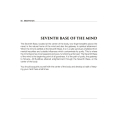spiritual development : ค้นหาหนังสือธรรมะ หน้า 32 / 40
หน้าหนังสือทั้งหมด

21
English for Buddhism Lovers
English for Buddhism Lovers
By: Dr. Apirompan Vasavakul
คำที่นำมุขแล้วนี้ เกี่ยวข้องกับ
งานถวายเหล่าของศตวรรษอาจารย์ ที่ไม่มีองค์ที่มาน่ามาก..
เสาหิน
foundation pile
(ผานีอิ่น, ไทย)
ระดับฐาน, เพรส
This text focuses on the terminology and practices related to Buddhist ceremonies, specifically the construction of a foundation pile for a temple. It discusses the significance of the events and invi

58
ผลการปฏิบัติธรรมและการอธิษฐาน
ผลการปฏิบัติธรรม
เรื่อง: อธิษมั วิชาชา
เมื่อถึงองค์พระและมองในกลางองค์พระก็จะเห็นองค์พระที่อยู่ในกลางองค์พระ อาตมาได้ทดลองมองไปที่ศูนย์กลางกายฐานที่ 7 และหยุด
พระลัย จง ลง สติรมโส จากประเทศไต้หวัน
"
บทความนี้นำเสนอประสบการณ์การปฏิบัติธรรมของผู้ที่เข้าร่วมโครงการอุปสมบทหมู่ธรรมทายาท โดยมีการพูดถึงการค้นพบความสุขจากการทำสมาธิและการมุงย้อนกลับไปหาอริยสัจ รวมถึงความหมายของชีวิตเมื่อสูญเสียคนที่รัก.Ke

60
The Uncertainty of Rebirth and Knowledge
"Reverend sir, you yourself know that I was going to the weaver’s workshop with my shuttle-basket in hand.
So when you asked me, ‘Where are you going?’ I knew very well that your meaning was, ‘When
In this dialogue, the Teacher questions a woman about her understanding of rebirth and death. She expresses her awareness of her mortality but acknowledges her ignorance regarding the specifics of her

46
The Difference Between Monks and Street Beggars
What then is the difference between a monk, and a regular beggar on the street? Monks also depend on alms gathering, and although this same word is used for beggars, the act in itself, is entirely dif
The text discusses the fundamental differences between monks and street beggars. While both seek alms, begging for monks is an act of humility and dignity, whereas for beggars it often signifies despe

84
The Seventh Base of the Mind
80 MEDICATION
SEVENTH BASE OF THE MIND
The Seventh Base, located at the center of the body, two finger-breadths above the navel, is the natural home of the mind and also the gateway to spiritual att
The Seventh Base is located two finger-breadths above the navel and is essential for the mind's tranquility. It serves as a protective shelter from mental impurities. This center is crucial for achiev

53
Understanding Dhamma and Nibbāna in Buddhism
With regard to dhamma as the 'essence' of the Buddha and Arhat disciples, however, it may be more appropriate to refer to 'Nibbāna,' for once they have attained Buddhahood and Arhatship their spiritua
This text explores the concept of dhamma in relation to the Buddha and Arhat disciples, particularly the notion of Nibbāna as the essence of their enlightenment. It argues that dhamma, especially in t

65
The Characteristics of Paccekabuddhas in Apadāna Literature
In the Apadāna literature, besides the life history of the Buddha and his disciples, a section is devoted to a depiction of the characteristics of Paccekabuddhas. This - section is entitled 'Paccekabu
The Apadāna literature highlights the characteristics of Paccekabuddhas, emphasizing their significant dhammas and independent mind. Verse 52 describes them as having great dhammas, being free from su

74
Understanding Dhammakāya and Enlightenment
the function of each particular transcendent dhamma.116 The totality of transcendental qualities constituting each transcendental state, which is identified earlier with dhammakāya, denotes a degree o
This text analyses the concept of dhammakāya, highlighting its connection to enlightenment and the associated happiness. It emphasizes the blameless nature of dhammakāya and notes Gotami's insights in

83
Understanding Dhammakāya in Theravāda Buddhism
In a few passages, however, Sāriputta also refers to the term dhammakāya in the sense of the Buddha’s teaching.150
On the whole, traditional Theravādins interpret the term dhammakāya mostly in the se
This passage examines the term 'dhammakāya' as interpreted in traditional Theravāda Buddhism. It discusses the general view of dhammakāya as reflecting the qualities of the Buddha and the spiritual re

90
Buddhist Manuscripts from Sipsong Panna Region
Buddhist manuscripts from the Sipsong Panna region can be divided into four categories. The first category consists of the Dai Pāli Tripiṭaka and Tripiṭaka commentary (三藏琢) which is represented by fiv
Buddhist manuscripts from the Sipsong Panna region are categorized into four main groups: the Dai Pāli Tripiṭaka and Tripiṭaka commentary, frequently used Pāli Canon texts, Theravāda Buddhist literatu

58
A Conversation with the Supremely Enlightened One
58
The multitude were offended and said, "Look, this daughter of a weaver talks as she pleases with the Supremely Enlightened One. When he asked her, 'From where do you come?' she should have answer
In this passage, a weaver's daughter engages in a profound conversation with the Supremely Enlightened One. The crowd is initially offended by her casual manner. When questioned about her origins, she

36
Understanding Novice Ordination in Buddhism
7. Abstaining from singing and dancing and other activities that may lead you to temptation
8. Abstaining from immodest dressing and appearance
9. Abstaining from indolent sleeping habits
10. Abstaini
Ordination in Buddhism is a significant ritual that marks the commitment of individuals to follow the teachings of the Buddha. The ten precepts outlined offer a moral framework for novices, highlighti

65
Dhammakaya Temple: A Community of Peace and Meditation
The Dhammakaya Temple is more than just temple buildings. It is a community that exemplifies a culture of peace and non-violence where meditation comes first and material concerns come last.
Establis
The Dhammakaya Temple, established on February 20, 1970, embodies a culture of peace and meditation, prioritizing spiritual growth over material concerns. It features the largest meditation hall, capa

108
The Sublime Attributes of the Lord
Sabbāñutāläñā pävarasiãm] is the sublime head of the Lord.
Nibbānarammaña pavarasitakesaṃ: the wisdom that recognizes Nibbāna as the object of consciousness is the sublime hair of the Lord. Catuttajj
This text discusses the sublime qualities of the Lord, emphasizing various forms of wisdom, such as the recognition of Nibbāna as the object of consciousness and the wisdom that leads to divine hearin

134
Exploring Daoist and Buddhist Visualization Techniques
The second one is the "Golden Palace" which is located below the heart and spleen, and the last field is the "Mud Pill Court" or the Palace of Ni-wan which is located about three inches within the hea
The text discusses the Golden Palace and the Mud Pill Court in relation to Daoist meditation. It highlights the visualization techniques associated with the cinnabar field, emphasizing its significanc

55
International Dhammadayada Ordination Program 2013
HOW MUCH DO YOU L-O-V-E YOURSELF ?
看您有多爱自己?
โครงการบรรพชาอุปสมบทหมู่ธรรมทายาทนานาชาติ IDOP รุ่นที่ 11
国际佛法新传者短期出家活动
14 July – 14 August 2013 (32 Days)
International Dhammadayada Ordination Program 201
The International Dhammadayada Ordination Program (IDOP) offers a unique opportunity for individuals to experience monastic life. Scheduled from July 14 to August 14, 2013, this 32-day program welcome

32
Ceremony of Recognition Among Monks
- The first image (top) shows two monks, one handing an award or plaque to the other, with other monks in the background.
- The second image (bottom left) depicts a formal event with a seated monk in
This content describes a set of images depicting a ceremonial event with monks. The first image portrays one monk awarding another, indicating a recognition of merit. The second image features a monk

10
Ceremonial Gatherings in Monastic Life
- The first image shows young monks dressed in orange robes, walking in a line, some holding fans or parasols.
- The second image depicts a group of women, most with their hands in a prayer gesture, s
This content portrays the rich traditions and ceremonial gatherings within monastic life, showcasing young monks in their distinctive orange robes, participating in processions. Women in white attire

26
The Teachings of Venerable Sariputta
26
At that moment Venerable Sariputta showed himself at the door of the former executioner's house.
When the man saw the Venerable, he paid obeisance to him. And escorting him into his house, he p
In this passage, Venerable Sariputta visits an executioner's house, where the executioner, Tambadathika, struggles with guilt over his past actions. Sariputta tactfully prompts him to reflect on his r

34
Taking Refuge in Buddhism
Three Refuges" Ever since then, Taking Refuge has remained the standard by which all novices are ordained, even to this day.
The process of ordaining novices according to "Taking Refuge" entails the
The text outlines the traditional process of ordaining novices in Buddhism, emphasizing the Taking Refuge ceremony. This involves shaving the head, wearing saffron robes, and seeking blessings from a
